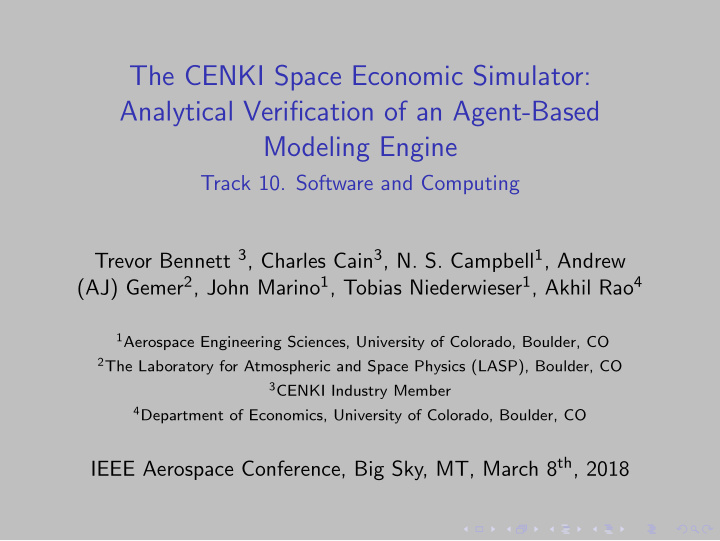



The CENKI Space Economic Simulator: Analytical Verification of an Agent-Based Modeling Engine Track 10. Software and Computing Trevor Bennett 3 , Charles Cain 3 , N. S. Campbell 1 , Andrew (AJ) Gemer 2 , John Marino 1 , Tobias Niederwieser 1 , Akhil Rao 4 1 Aerospace Engineering Sciences, University of Colorado, Boulder, CO 2 The Laboratory for Atmospheric and Space Physics (LASP), Boulder, CO 3 CENKI Industry Member 4 Department of Economics, University of Colorado, Boulder, CO IEEE Aerospace Conference, Big Sky, MT, March 8 th , 2018
Background CENKI The Committee for Expansion into Key Space Industries ◮ Formed in 2016 out of a CU special topics project with ULA ◮ Space is complex ◮ Need for community consensus Mission Statement: CENKI will assemble the community and technical resources to stimulate the development of a thriving space economy
The problem ◮ There is a need to model economic interactions between actors in space industries ◮ Existing solutions can optimize logistics or behaviors; existing approaches can model specific scenarios ◮ What’s missing is a general framework to model diverse, decentralized actors across sectors
The problem ◮ What’s missing is a general framework to model diverse, decentralized actors across sectors Such a framework could answer questions like: ◮ What types of competition are likely in space industries? ◮ How will technical or economic decisions impact inter-industry linkages? ◮ How might regulations interact with industry profitability and Gross Space Product?
The problem ◮ What’s missing is a general framework to model diverse, decentralized actors across sectors Such a framework would 1. allow flexibility in defining player logic and importing custom data/models as inputs 2. perform consistent aggregation of choices and outcomes 3. solve for market prices and reflect policy constraints
Agent-Based Modeling Agent-Based Models Agent-Based Models (ABM) are computational models in which rule-based objects (“agents”) interact independent of central control. Our Solution: the CENKI SES Use ABM to build up individual decisions and interactions. Agents interact in the marketplace, which tracks transactions and aggregates outcomes.
How it works ◮ Players are collections of Agents ◮ Agents may be Customers or Providers ◮ Customers issue Contracts , and Providers submit Bids ◮ When a Customer’s best interest is fulfilled by a particular Bid and a Provider’s best interest is fulfilled by a particular Contract, the two agents complete a Deal
SES Overview
Study layout This study We verify that the SES reproduces analytical solutions to economic models.
Study layout We study three models, progressively increasing in complexity. 1. Model A1 : Competition between two providers 2. Model A2 : Competition with production from reserves 3. Model A3 : Competition with production and supply chain In all of these models, providers supply undifferentiated goods and customers select the lowest-cost providers (Bertrand competition).
A1 and A2 layout
Model A1 ◮ Lines represent the analytical model ◮ Circles represent simulation values
Model A2 In this model, satellites must be produced using available transponders and buses
A3 layout In this model, satellites must be produced using purchased transponders and buses
Model A3
Summary Commercial space is complex. Complexity extends to ◮ supply chains and production decisions; ◮ random events and environmental hazards; ◮ regulatory policies and long-term agreements.
Summary Commercial space is complex. Complexity extends to ◮ supply chains and production decisions; ◮ random events and environmental hazards; ◮ regulatory policies and long-term agreements. The SES addresses this complexity by ◮ allowing users to flexibly specify players and products, ◮ allowing users to supply custom inputs to players and simulate realizations over inputs, and ◮ mediating and aggregating agent interactions through the marketplace.
SES with data? Use cases? Demonstrating Agent-Based Modeling on Satellite Market Data See 13.0205 in Canyon after this!
THANK YOU! Questions / Comments? www.cenki.space
Recommend
More recommend